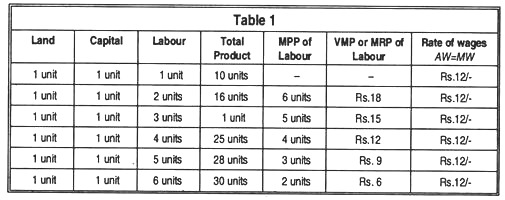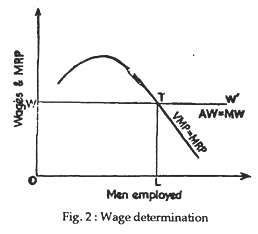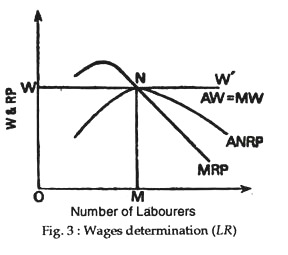Essay on Marginal Productivity Theory!
The marginal productivity theory of distribution, as developed by J. B. Clark, Wick-steed and others during the last quarter of the 19th century, seeks to provide a general explanation of how the price (or the earnings) of a factor of production is determined. In other words, it lays down the broad principles of the distribution of the national product among the factors of production such as, land, labour, capital and entrepreneur.
According to this theory, the price (or the earnings) of a factor tends to equal the value of the marginal product of the factor under consideration. Thus rent is equal to the value of the marginal product (VMP) of land; wages are equal to the VMP of labour and so on.
The exponents of the theory have applied the same principle of profit-maximisation (viz., MC=MR) to determine the factor price. Just as an entrepreneur maximises his total profits when he equates MC and MR, he is also maximising profits if he equates the marginal productivity of each factor with its marginal cost.
ADVERTISEMENTS:
Essay on the Assumptions of the Theory:
The marginal productivity theory of distribution is based on several assumptions.
(i) Perfect competition in both product and factor markets:
The theory assumes the perfect competition in both product and factor markets. It implies that both the price of the product and the price of the factor (say, labour) remain unchanged in each case.
ADVERTISEMENTS:
(ii) Operation of the Law of Diminishing Marginal Returns:
It is also assumed that the marginal product of the factor under consideration would diminish as the number of the said factor is increased while keeping other factors constant.
(iii) Homogeneous and divisible units of the factor:
All the units of a factor are divisible and homogeneous. It means that a factor can be divided into small kind and of the same quality.
ADVERTISEMENTS:
(iv) Operation of the principle of substitution:
The theory assumes the possibility of the substitution of the different factors. It means that the factors like labour, capital and others can be freely and easily substituted for one another.
(v) Profit maximisation:
The employer will employ the different factors in such a way and in such a proportion that he will get the maximum profits. This he can achieve by employing each factor up to that number at which the price of each (which is nothing but MC because of perfect competition) is equal to its value of marginal product (which is nothing but MR because of perfect competition).
(vi) Full employment of factors:
The theory assumes full employment for factors; otherwise each factor cannot be paid in accordance with its marginal productivity. If some units of a particular factor remain unemployed, they would then be willing to accept the employment at a price less than the value of their marginal product.
(vii) Exhaustion of the total product:
The theory also assumes that the payment to each factor according to its marginal productivity completely exhausts the total product.
Essay on the Explanation and Illustration of the Theory:
ADVERTISEMENTS:
On the basis of these assumptions, the theory begins with the consideration of the marginal physical productivity of a factor for a single firm. The marginal physical product (MPP) of a factor, say, of labour, is the increase in the total product of the firm as additional men are taken in. If we multiply the marginal physical product of a factor by the price of the product, we would get the value of the marginal product (VMP) of the factor.
As the theory assumes the existence of perfect competition, the VMP of the factor is equal to the marginal revenue product of the factor (MRP), which is the addition to the total revenue when successive marginal units of a factor are added to the fixed amount of other factors, or MRP=MPP X MR under perfect competition.
It is simply marginal physical product multiplied by constant price, as P=MR. [VMP of a factor=MPP of the factor X price of the product per unit, and MRP of a factor=MPP of the factor X MR under perfect competition. So in such a market situation, VMP of a factor = MRP of that factor.]
The theory states that the firm employs each factor up to that number where its price is equal to the VMP of the factor. Thus, wages tend to be equal to the VMP of labour; interest is equal to VMP of capital and so on.
ADVERTISEMENTS:
By doing so, it maximises its total profits, as its marginal cost (i.e., the price of an additional unit of the variable factor) is equal to marginal revenue (which is the same as the VMP or MRP of the factor under the assumption of perfect competition). Let us illustrate the theory with reference to the determine of the price of labour, i.e., wages.
Let us suppose that the price of the product is Rs.3 (constant). As the number of factors other than labour are Rs.12 (constant). As the number of factors other than labour remain un-changed, wages represent the marginal cost (MC).
The table shows that at 2 or 3 labourers, the VMP or MRP of labour is greater than wages; so the firm can increase total profits by employing an additional labour. But at 5 or 6 labourers, the VMP or MRP of labour is less than wages, so it would reduce the number of labourers. But when it employs 4 labourers, the wages (Rs.12) become equal to the VMP or MRP of labour (also Rs.12).
Here the firm gets the maximum profits because its marginal cost (which is nothing but marginal wages, Rs.12, in the illustration) is equal to its marginal revenue (which is nothing but VMP or MRP, Rs 12 in the illustration). It shows that under the assumption of perfect competition a firm employs a factor up to that number at which the price of the factor is just equal to the value of the marginal product (=MRP of the factor) In the same way it can be shown that rent is equal to the VMP of land, interest is equal to the VMP of capital, and so forth.
ADVERTISEMENTS:
Diagrammatic Illustration:
The theory is illustrated in Fig. 2: In the figure WW is the line of wages indicating the constant rate of wages at all levels of employment (AW=MW, where, AW is the average wage and MW, the marginal wage). The VMP line shows the value of marginal product curve of labour, and it goes downwards from left to right indicating diminishing marginal product of labour. The figure shows that the firm employs OL number of labourers as here wages (O W or LT) is equal to the VMP or MRP of labour (LT). So in equilibrium of a firm, MRP of labour=A W=MW.
It is to be noted that for the equilibrium of the industry wages should also be equal to the average revenue product (ARP) of la- Men employed labour, giving only the normal profits. The ARP of labour is defined as the total revenue attributable to labour only divided by the number of men employed.
If, in the long run, wages are less than ARP of labour the firm will get excess profits, which will attract new firm into the industry causing an increase in the demand for labour and a consequent rise in wages upto ANRP of labour. The reverse happens when wages are greater than ANRP of labour. So in the long run.
ADVERTISEMENTS:
MW=AW=MRP of Labour=ANRP of Labour.
In Fig 3, WW is the wage line under perfect competition in the labour market. The curves MRP and ANRP, are marginal revenue product and average not revenue product’ of labour respectively. The figure shows that when OM number of workers are employed, the wage rate, OW become equal to both MRP and ARP of labour. So, an employer would employ OM quantity of labour in the long-run under perfect competition.
Essay on Criticism of marginal productivity theory:
The marginal productivity theory of distribution has been subjected to a number of criticisms the chief of which are given below:
(i) Marginal product is indeterminate:
ADVERTISEMENTS:
Tausig and Davenport have pointed out that every product is a joint product-produced by all the factors jointly. Hence the marginal product of any particular factor (say, of labour or of capital) cannot be separately determined.
(ii) Exhaustion of the total product before the completion of the distribution:
It is also shown that the employment of one additional unit of a factor may cause an improvement in the whole of organisation in such a way that the marginal product will increase. In such circumstances, if the factor is paid in accordance with the value of marginal product, the total product will be exhausted before the distribution is completed.
(iii) Assumption of an unrealistic condition:
The theory assumes the existence of perfect competition, which is hardly found in real life But Chamberlin has shown that the theory can also be applied in the case of monopoly and imperfect competition, where the marginal price of a factor would be equal to its MRP (not to its VMP). Again, the assumption of full employment is also unrealistic.
(iv) Substitution not always possible:
ADVERTISEMENTS:
Modern economists rule out the possibility of free substitution of the factors always owing to the technical conditions of business.
(v) Emphasis on the demand side only:
The theory is one sided as it ignores the supply side of a factor; it has emphasised only the demand side i.e., the employer’s side. In the opinion of Samuelson, the marginal productivity theory is simply “a theory of one aspect of the demand for productive services by the firm”.
(vi) Inhuman theory:
The theory is often described as ‘inhuman’ as it treats human and non-human factors alike for the determination of factor prices.


